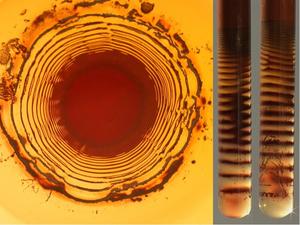Effects, anomalies and natural occurences of Liesegang patterns
Beyond some artificial experiments Liesegang patterns can appear in nature in very different systems (bones, teeth, agate rocks, tumors, bacterial colonies, alloys etc.) Therefore as a mineralogist stated somewhere during the 20th century anything that had a stripy pattern hardly avoided to be affiliated with Liesegang rings ...
Which theory is the correct one?
The greatest problem with the existing models of periodic precipitation was that although they use sometimes completely different approaches they are all partially succesfull. From this naturally arises the question: who can decide which theory is correct, and how?



But whant about these? Cross section of an agate crystal and stripy pattern in a sand wall (interior of a vine cellar near to Pannonhalma, Hungary)

Is there a general model at all?
Another problem arises from the fact that in the literature there are many reports about different kinds of anomalous patterning.
Is there a global model that can account for all these special patterning trends, or are these completely different effects that need their own distinct models?
Due to the fact that since 1896 nobody was able to suggest a general theory, most of the scientists believe that periodic precipitation is not a single effect, and such a general description does not exist at all.

The Liesegang "checklist"
Beyond the natural patterns about that it is hard to tell whether the same machnism has formed them as the Liesegang rings there are many anomalies and special patterning trends that has been observed in laboratory experiments.
Therefore if a general model exists at all, it must be able to account for at least the following observations:
- Normal patterning (spacing law, time law, width law, Matalon-Packter law)
- Revert patterning (totally, partially and recurrently revert patterns)
- Double banding (two periodicities in the same system)
- Chaotic patterning
- Formation of ball and ellipsoid like precipitate zones
- Explanation of the propagating defects both in 2 and 3D
- Formation of spirals (2D) and helices (3D)
- Effect of gravity
- Effect of competitve complex formation that is description of the so-called heterogeneous traveling waves


